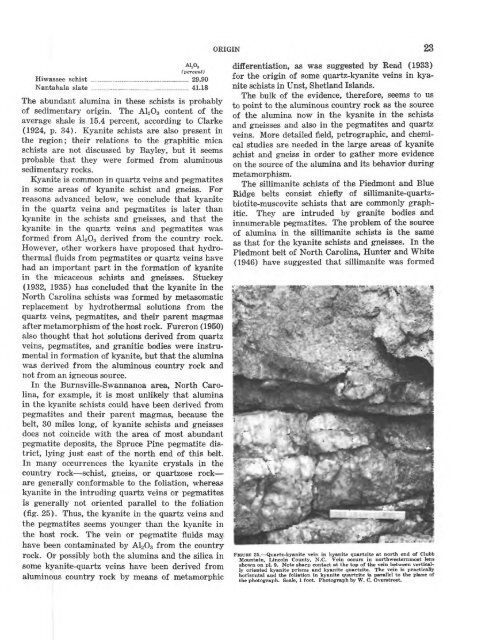Kyanite, Sillimanite, and Andalusite Deposits of the Southeastern ...
Kyanite, Sillimanite, and Andalusite Deposits of the Southeastern ...
Kyanite, Sillimanite, and Andalusite Deposits of the Southeastern ...
Create successful ePaper yourself
Turn your PDF publications into a flip-book with our unique Google optimized e-Paper software.
ORIGIN 23<br />
(percent)<br />
Hiwassee schist -__ . _. . .._._. _________ 29.90<br />
Nantahala slate ______________________ _____.____________. 41.18<br />
The abundant alumina in <strong>the</strong>se schists is probably<br />
<strong>of</strong> sedimentary origin. The A1203 content <strong>of</strong> <strong>the</strong><br />
average shale is 15.4 percent, according to Clarke<br />
(1924, p. 34). <strong>Kyanite</strong> schists are also present in<br />
<strong>the</strong> region; <strong>the</strong>ir relations to <strong>the</strong> graphitic mica<br />
schists are not discussed by Bayley, but it seems<br />
probable that <strong>the</strong>y were formed from aluminous<br />
sedimentary rocks.<br />
<strong>Kyanite</strong> is common in quartz veins <strong>and</strong> pegmatites<br />
in some areas <strong>of</strong> kyanite schist <strong>and</strong> gneiss. For<br />
reasons advanced below, we conclude that kyanite<br />
in <strong>the</strong> quartz veins <strong>and</strong> pegmatites is later than<br />
kyanite in <strong>the</strong> schists <strong>and</strong> gneisses, <strong>and</strong> that <strong>the</strong><br />
kyanite in <strong>the</strong> quartz veins <strong>and</strong> pegmatites was<br />
formed from A1203 derived from <strong>the</strong> country rock.<br />
However, o<strong>the</strong>r workers have proposed that hydro<strong>the</strong>rmal<br />
fluids from pegmatites or quartz veins have<br />
had an important part in <strong>the</strong> formation <strong>of</strong> kyanite<br />
in <strong>the</strong> micaceous schists <strong>and</strong> gneisses. Stuckey<br />
(1932, 1935) has concluded that <strong>the</strong> kyanite in <strong>the</strong><br />
North Carolina schists was formed by metasomatic<br />
replacement by hydro<strong>the</strong>rmal solutions from <strong>the</strong><br />
quartz veins, pegmatites, <strong>and</strong> <strong>the</strong>ir parent magmas<br />
after metamorphism <strong>of</strong> <strong>the</strong> host rock. Furcron (1950)<br />
also thought that hot solutions derived from quartz<br />
veins, pegmatites, <strong>and</strong> granitic bodies were instrumental<br />
in formation <strong>of</strong> kyanite, but that <strong>the</strong> alumina<br />
was derived from <strong>the</strong> aluminous country rock <strong>and</strong><br />
not from an igneous source.<br />
In <strong>the</strong> Burnsville-Swannanoa area, North Carolina,<br />
for example, it is most unlikely that alumina<br />
in <strong>the</strong> kyanite schists could have been derived from<br />
pegmatites <strong>and</strong> <strong>the</strong>ir parent magmas, because <strong>the</strong><br />
belt, 30 miles long, <strong>of</strong> kyanite schists <strong>and</strong> gneisses<br />
does not coincide with <strong>the</strong> area <strong>of</strong> most abundant<br />
pegmatite deposits, <strong>the</strong> Spruce Pine pegmatite district,<br />
lying just east <strong>of</strong> <strong>the</strong> north end <strong>of</strong> this belt.<br />
In many occurrences <strong>the</strong> kyanite crystals in <strong>the</strong><br />
country rock schist, gneiss, or quartzose rock<br />
are generally conformable to <strong>the</strong> foliation, whereas<br />
kyanite in <strong>the</strong> intruding quartz veins or pegmatites<br />
is generally not oriented parallel to <strong>the</strong> foliation<br />
(fig. 25). Thus, <strong>the</strong> kyanite in <strong>the</strong> quartz veins <strong>and</strong><br />
<strong>the</strong> pegmatites seems younger than <strong>the</strong> kyanite in<br />
<strong>the</strong> host rock. The vein or pegmatite fluids may.<br />
have been contaminated by A1203 from <strong>the</strong> country<br />
rock. Or possibly both <strong>the</strong> alumina <strong>and</strong> <strong>the</strong> silica in<br />
some kyanite-quartz veins have been derived from<br />
aluminous country rock by means <strong>of</strong> metamorphic<br />
differentiation, as was suggested by Read (1933)<br />
for <strong>the</strong> origin <strong>of</strong> some quartz-kyanite veins in kyanite<br />
schists in Unst, Shetl<strong>and</strong> Isl<strong>and</strong>s.<br />
The bulk <strong>of</strong> <strong>the</strong> evidence, <strong>the</strong>refore, seems to us<br />
to point to <strong>the</strong> aluminous country rock as <strong>the</strong> source<br />
<strong>of</strong> <strong>the</strong> alumina now in <strong>the</strong> kyanite in <strong>the</strong> schists<br />
<strong>and</strong> gneisses <strong>and</strong> also in <strong>the</strong> pegmatites <strong>and</strong> quartz<br />
veins. More detailed field, petrographic, <strong>and</strong> chemical<br />
studies are needed in <strong>the</strong> large areas <strong>of</strong> kyanite<br />
schist <strong>and</strong> gneiss in order to ga<strong>the</strong>r more evidence<br />
on <strong>the</strong> source <strong>of</strong> <strong>the</strong> alumina <strong>and</strong> its behavior during<br />
metamorphism.<br />
The sillimanite schists <strong>of</strong> <strong>the</strong> Piedmont <strong>and</strong> Blue<br />
Ridge belts consist chiefly <strong>of</strong> sillimanite-quartzbiotite-muscovite<br />
schists that are commonly graph<br />
itic. They are intruded by granite bodies <strong>and</strong><br />
innumerable pegmatites. The problem <strong>of</strong> <strong>the</strong> source<br />
<strong>of</strong> alumina in <strong>the</strong> sillimanite schists is <strong>the</strong> same<br />
as that for <strong>the</strong> kyanite schists <strong>and</strong> gneisses. In <strong>the</strong><br />
Piedmont belt <strong>of</strong> North Carolina, Hunter <strong>and</strong> White<br />
(1946) have suggested that sillimanite was formed<br />
FIGURE 25. Quartz-kyanite vein in kyanite quartzite at north end <strong>of</strong> Clubb<br />
Mountain, Lincoln County, N.C. Vein occurs in northwesternmost lens<br />
shown on pi. 9. Note sharp contact at <strong>the</strong> top <strong>of</strong> <strong>the</strong> vein between vertically<br />
oriented kyanite prisms <strong>and</strong> kyanite quartzite. The vein is practically<br />
horizontal <strong>and</strong> <strong>the</strong> foliation in kyanite quartzite is parallel to <strong>the</strong> plane <strong>of</strong><br />
<strong>the</strong> photograph. Scale, 1 foot. Photograph by W. C. Overstreet.
















